When I think about whale watching in Montauk, one image comes to mind—the majestic humpback whale. These incredible creatures are more than just a sight to see; they’re a symbol of the vibrant marine life that makes Montauk’s waters so special. Over the years, I’ve learned so much about humpback whales in Montauk, and every encounter feels like a gift from nature. Whether you’re a local or a visitor, spotting a humpback whale in Montauk is an experience you’ll never forget.
What Do Humpback Whales Look Like?
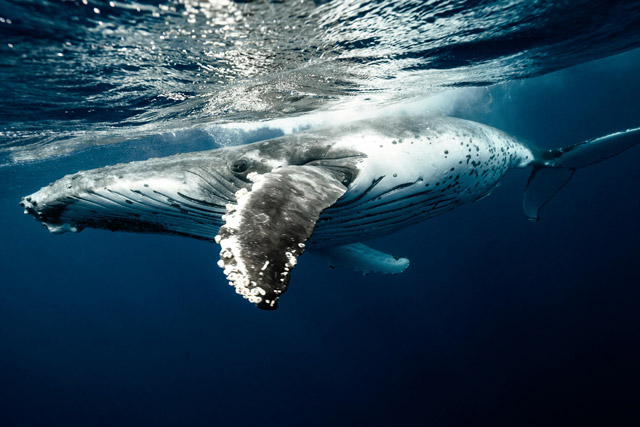
Humpback whales are among the most recognizable creatures in the ocean, and seeing one in the wild is an unforgettable experience. These gentle giants are not only enormous but also uniquely beautiful, with features that set them apart from other whale species.
Size and Shape
Humpback whales are truly massive, growing up to 60 feet long and weighing as much as 40 tons. To put that into perspective, that’s about the length of a school bus and the weight of 24 average cars! Despite their size, humpbacks are incredibly graceful swimmers.
Their bodies are long and streamlined, with a rounded head covered in small bumps called tubercles. These bumps are actually hair follicles, which scientists believe play a role in helping the whales sense their environment.
Coloration
Most humpbacks are a mix of black, gray, and white. Their undersides often have unique white markings that make it possible to identify individual whales. These patterns are as unique as fingerprints and are used by researchers to track and study them.
Fun Fact!
Humpback whales have the longest pectoral fins of any whale species. These fins can grow up to 16 feet long, which is about one-third of their body length!
Flukes and Tail Patterns
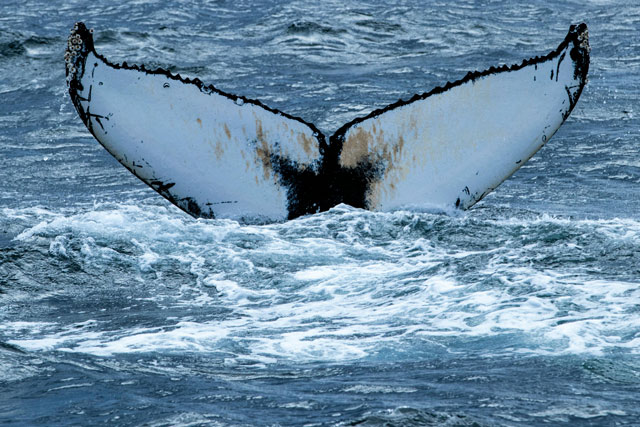
The humpback whale’s fluke, or tail, is one of its most stunning features. Each fluke has a distinct pattern of black and white, with a serrated edge that makes it look like a work of art. These patterns are used in photo-identification studies, helping scientists learn more about their migration routes and behaviors.
Pro Tip!
If you’re on a whale-watching tour and see a humpback dive, keep your camera ready! When they lift their fluke out of the water, it’s a perfect moment to capture their unique tail pattern on film.
Why They’re Called Humpbacks
Humpback whales get their name from the way they arch their backs dramatically before making a deep dive. This “hump” is especially noticeable when they’re preparing for a long dive into deeper waters.
Distinctive Behavior: The Playful Side of Humpback Whales in Montauk

Humpback whales are not just breathtaking to look at—they’re also some of the most active and entertaining marine animals you’ll ever encounter. Their remarkable behaviors add a layer of excitement to any whale-watching experience, making them unforgettable for both beginners and seasoned enthusiasts.
Breaching: The Whale Leap
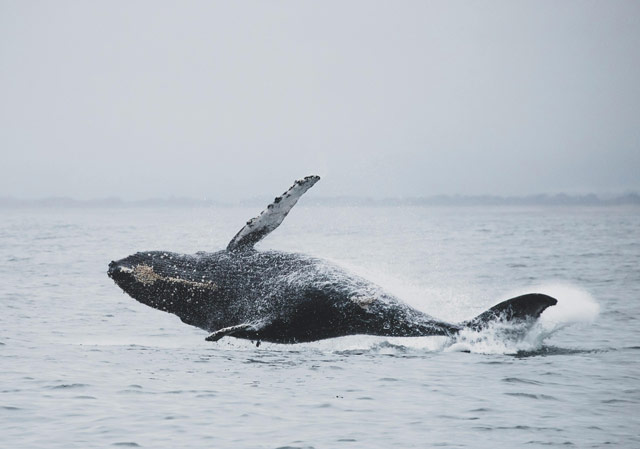
One of the most spectacular sights in the ocean is a humpback whale breaching. Imagine a 40-ton giant launching itself almost completely out of the water, only to come crashing back down with a thunderous splash! This dramatic leap isn’t just for show. Scientists believe breaching may help whales communicate over long distances, dislodge parasites from their skin, or simply play and express energy.
Fun Fact!
Humpback whales are known to breach more often than almost any other whale species. It’s like they’re putting on a show just for us!
Tail Slapping: Making Waves
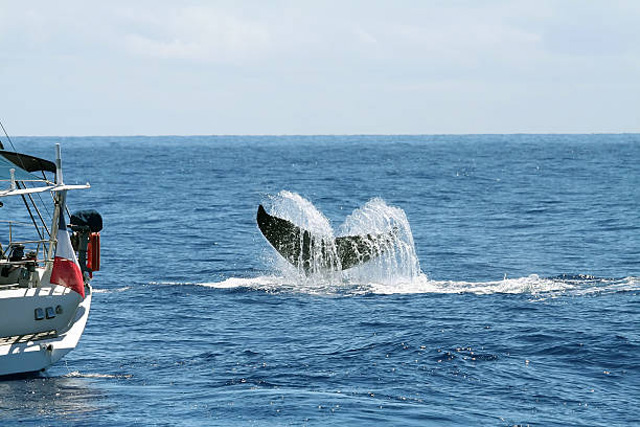
Another fascinating behavior is tail slapping, where a humpback lifts its massive fluke out of the water and slams it down hard. This creates an enormous splash and a loud, echoing sound that can carry for miles underwater. Tail slapping may be a way for whales to communicate, warn off predators, or simply enjoy themselves.
Pectoral Fin Slapping: Waving Hello
Humpbacks also use their incredibly long pectoral fins in a behavior called pectoral slapping. They lie on their sides or backs and repeatedly smack the water with their fins, creating a loud, rhythmic sound. This behavior might serve as a form of communication or courtship display.
Pro Tip!
If you’re on a whale-watching tour and notice a humpback slapping its fins or tail, keep watching. These behaviors often precede a spectacular breach!
Bubble Net Feeding: A Team Effort
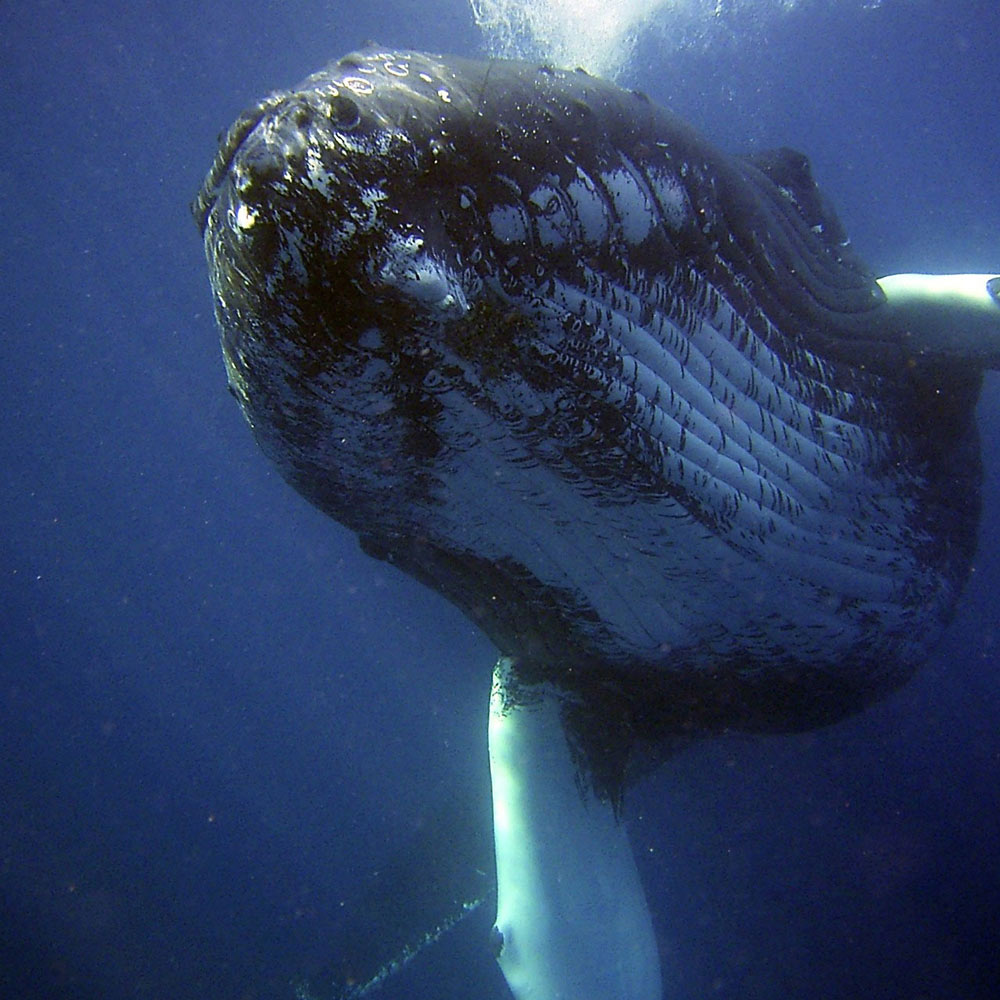
Humpbacks are also famous for their unique feeding technique called bubble net feeding. A group of whales works together to release bubbles in a spiral pattern beneath a school of fish. This creates a “net” that traps the fish, allowing the whales to swim up and gulp them down. It’s a rare and mesmerizing behavior that shows just how intelligent these creatures are.
Playful Acrobatics
Humpbacks are natural performers. They’re known to roll on their sides, spin, and even engage in what looks like synchronized swimming. These playful behaviors of humpback whales in Montauk and elsewhere are thought to be a form of social bonding, especially among younger whales.
Singing: The Humpback’s Song
No discussion of humpback behavior would be complete without mentioning their songs. Male humpbacks produce complex and hauntingly beautiful songs that can last up to 20 minutes and be repeated for hours. Scientists are still studying the purpose of these songs, but they’re believed to play a role in attracting mates and marking territory.
Fun Fact!
Humpback songs can travel thousands of miles underwater, making them some of the loudest and farthest-reaching sounds in the animal kingdom.
Why These Behaviors Matter
Each of these behaviors is more than just fascinating to watch—they’re a window into the lives of humpbacks and their interactions with their environment. Observing these behaviors in the wild helps researchers learn more about their social structures, communication, and survival strategies.
What and How Do Humpback Whales in Montauk Eat?
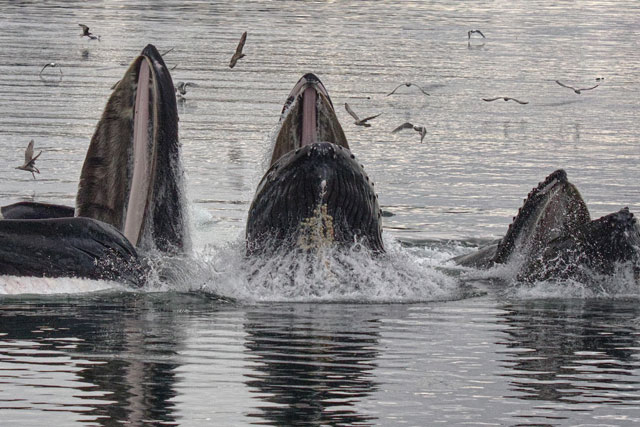
Humpback whales may be massive, but their diet consists of some of the tiniest creatures in the ocean. These gentle giants are filter feeders, relying on clever techniques and unique physical adaptations to consume vast amounts of food every day.
What’s on the Menu?
Humpback whales in Montauk primarily eat krill, small fish, and plankton. Their diet depends on the region and the season, but these nutrient-rich morsels provide the energy humpbacks need to fuel their long migrations and active lifestyles.
Fun Fact!
Even though humpback whales are so big, they don’t have teeth. Instead, they use baleen plates to filter food from seawater.
Bubble Net Feeding: How it Works
One of the most fascinating feeding methods humpback whales in Montauk and beyond use is bubble net feeding. This behavior is a true marvel of teamwork and intelligence. Here’s how it works:
- A group of whales dives beneath a school of fish.
- One whale releases a spiral of bubbles that forms a “net” around the fish, herding them into a tight cluster.
- Other whales join in, creating noise and motion to corral the fish even further.
- Together, the whales swim upward through the dense school of fish with their mouths wide open, swallowing thousands of fish in one gulp.
This cooperative feeding behavior is not only efficient but also rare, making it an extraordinary sight for lucky observers.
Lunge Feeding: A Solo Strategy
Humpbacks also engage in lunge feeding, a method they can perform alone. In this technique, the whale propels itself toward a school of fish or krill with its mouth open, swallowing as much as possible in one dramatic gulp.
Their expandable throats, lined with deep grooves called ventral pleats, are key to this feeding style. These pleats allow the whale’s mouth to stretch and take in enormous amounts of water and food. Once their mouth is full, they close it and use their powerful tongue to push the water out through their baleen plates, trapping the food inside.
Why Do They Have Throat Grooves?
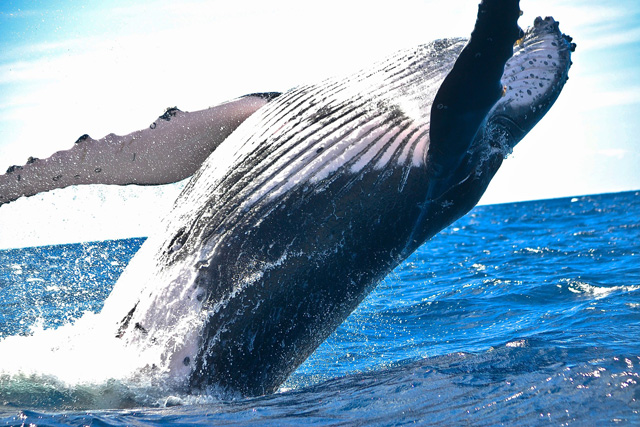
The ventral pleats are a signature feature of humpbacks and other baleen whales. These grooves run from the tip of their lower jaw down to their belly, enabling their throats to expand like an accordion during feeding. Without these grooves, humpbacks wouldn’t be able to consume the vast quantities of food they need to survive.
Fun Fact!
A humpback whale can expand its throat to hold a volume of water and food equal to the size of a small swimming pool.
Skimming the Surface
In addition to bubble net feeding and lunge feeding, humpbacks sometimes use a simpler method called surface skimming. By swimming with their mouths open near the surface, they can scoop up plankton and krill that are floating in the water. This technique is less dramatic than their other feeding behaviors but just as effective.
The Importance of Feeding Grounds
Humpback whales in Montauk spend months in the nutrient-rich feeding grounds, before migrating to warmer breeding grounds. During their migration, they eat very little, relying on the fat reserves built up during the feeding season to sustain them.
Pro Tip!
The best time to see humpbacks feeding near Montauk is during the summer and early fall when the waters are teeming with fish and krill.
Why Their Diet Matters
The feeding habits of humpback whales play a vital role in the ocean’s ecosystem. By consuming large quantities of fish and krill, they help regulate these populations and maintain a balanced marine environment. Plus, their nutrient-rich waste provides essential fertilizer for phytoplankton, which supports the entire ocean food chain.
Fun Fact!
Phytoplankton, fueled by whale poop, produces up to 50% of the oxygen we breathe. In a way, humpbacks are helping keep us alive, too!
Humpback Whale Migration
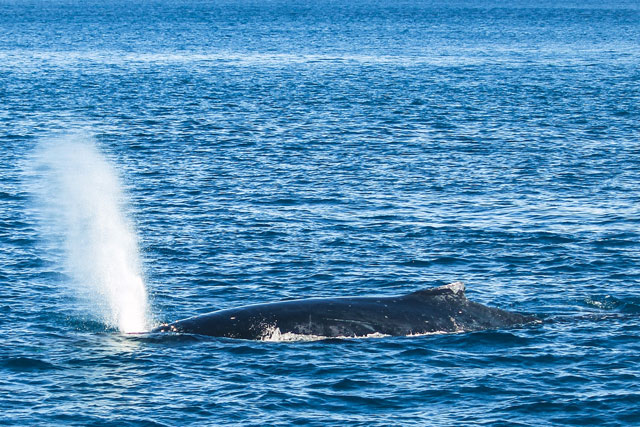
Humpback whales are incredible world travelers, undertaking one of the longest migrations of any mammal on Earth. Montauk plays a vital role in their journey, serving as a crucial feeding stop along their migratory path.
Where Are They Coming From?
The humpback whales you see off Montauk’s shores are likely migrating from warm tropical waters in the Caribbean, such as the Dominican Republic. These tropical waters are their winter breeding grounds, where they mate and give birth to calves. The warm, shallow waters provide a safe haven for newborn whales as they grow strong enough to embark on the long journey north.
Where Are They Headed?
After Montauk, many of these whales continue their journey to feeding grounds in cooler, nutrient-rich waters. Some head toward the Gulf of Maine, while others travel as far as Canada’s Bay of Fundy or even the icy waters of the Arctic. These areas are teeming with the fish, krill, and plankton that humpbacks need to fuel their massive bodies.
How Far Do They Travel?
Humpback whales travel an astonishing distance during their migrations—some cover up to 16,000 miles round trip each year! The stretch between their breeding grounds in the tropics and their feeding grounds in the north is a test of endurance, requiring them to rely on stored energy reserves when food is scarce.
Fun Fact!
During migration, humpback whales swim at an average speed of 3 to 6 miles per hour. At this rate, their journey can take weeks or even months to complete.
Conservation Efforts and Humpback Whales
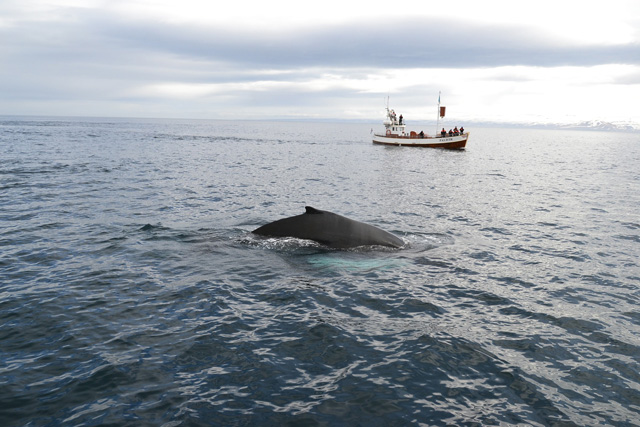
Humpback whales were once endangered due to commercial whaling, but thanks to global conservation efforts, their populations are making a remarkable recovery. Organizations in Montauk play a part by promoting eco-friendly whale watching and raising awareness about the importance of marine conservation.
By supporting these efforts, you’re not just enjoying a spectacular day on the water—you’re also contributing to the long-term protection of these incredible animals.
Montauk: A Haven for Humpback Whales
Montauk’s location is ideal for humpback whale sightings. The mixing currents off the coast create a thriving ecosystem teeming with marine life, from schools of baitfish to seabirds. This abundance of food makes Montauk a prime spot for humpbacks to stop and feast.
Tour operators in Montauk are also committed to sustainable practices, ensuring the safety of both the whales and the environment. This focus on conservation is one of the reasons Montauk remains a favorite destination for humpback whales and whale enthusiasts alike.


